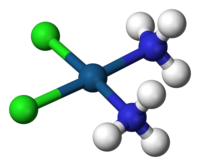
Photo from wikipedia
Abstract An improved and scalable synthetic route to chiral porphyrin cage compounds, which will be used as catalytic machines for the encoding of information into polymers, has been developed. The… Click to show full abstract
Abstract An improved and scalable synthetic route to chiral porphyrin cage compounds, which will be used as catalytic machines for the encoding of information into polymers, has been developed. The porphyrin cage was made chiral by introducing one or two nitro groups on its xylylene sidewalls. This nitration was performed with fuming nitric acid at low temperature and occurred in a highly regioselective fashion. The latter was thought to be the result of the binding of a nitronium cation inside the cavity of the cage compound, directing the reaction to the sidewalls. However, 1H NMR titrations of the porphyrin cage compound with either nitric acid or the nitronium salt [NO2][BF4] revealed that the effect of the host-guest binding of the nitronium ion on the selectivity of the reaction is negligible. Instead, protonation of the porphyrin plays an essential role as it prevents the ring from being oxidized, allowing the nitration to be directed to the sidewalls.
Journal Title: Tetrahedron
Year Published: 2019
Link to full text (if available)
Share on Social Media: Sign Up to like & get
recommendations!